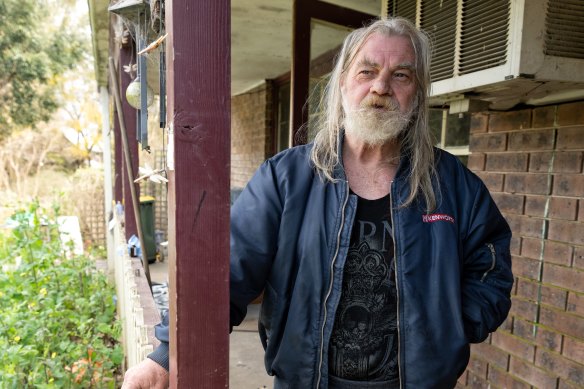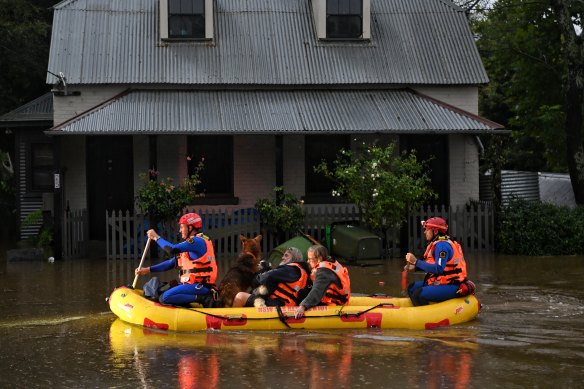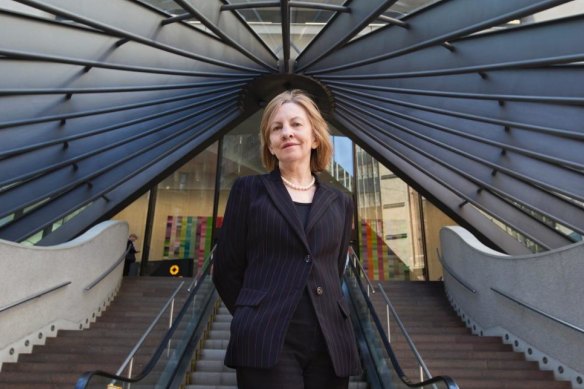After four floods in two years, Windsor resident Darrell Davis needs a fresh start – far away from the floodplains. So far, Davis has had little luck selling the family home of 20 years and jokes that the frequent water views aren’t attracting buyers.
Because he cannot afford to rebuild, now that he is retired, Davis only has two options: sell up or hope for a government buyback scheme.
Darrell Davis has lived in Windsor for the past 20 years, but the past 12 months of flooding have taken its toll, and the family are moving away.Credit:Nick Moir
“It’s [the flood level] just going up all the time,” Davis said. “We have put it up [for sale] as a knock-down rebuild because we don’t think the house is stable. Poor old girl [the house] has been through four major floods.”
The NSW government announced on Wednesday that they would accept expressions of interest from people in the Northern Rivers, and other NSW floodplains, who were interested in selling their house to the government in a buyback scheme. But the government’s flood report did not name the Hawkesbury Nepean region as a possible buyback area.
On Thursday, former chief scientist Professor Mary O’Kane, co-author of the flood report, said buyback and land swap schemes should be explored for the Hawkesbury Nepean region. She added, however, that the recommendations in the report were about giving the government a variety of options for them to select the most appropriate combination for a region.
Many western Sydney residents hoped the final report would determine whether the controversial raising of the Warragamba Dam wall should proceed. The report only indicated giving the project the green light would give people more time to evacuate, but the report said that “no single option is sufficient to adequately mitigate flood risk in the Valley for the range of flood probabilities – any action taken must be part of a multi-pronged strategy”.
Darrell Davis and his dog being rescued by the SES during the March 2021 flooding event. Credit:Nick Moir
Asked whether she favoured raising the wall, O’Kane said the “pros and cons had been spelt out. The reason we didn’t say ‘do this’ was because it is about a balance of which way we’re going to go”.
“[They’ve] got to make a decision that’s the best combination of things to do. There are many good answers to this problem.”
When pressed about a preferred option, O’Kane said: “I’d be looking at how much money [was available] and what that risk level looks like.”
Hawkesbury City Council Deputy Mayor Barry Calvert said his council favoured raising the dam wall, together with other mitigation tools, including a voluntary buyback or land swap scheme for those who want to leave and improving evacuation routes.
Former NSW chief scientist Mary O’Kane says raising the Warragamba Dam wall would depend on “how much money [was available] and what that risk level looks like.”
The flood report found that more than 40,000 people will be at risk of flooding by 2040 if development goes ahead without further mitigation measures. The population of flood-prone areas in Sydney is expected to rocket in the coming years.
North-western areas in Sydney including Blacktown, The Hills Shire and Hawkesbury councils have a target of 33,000 new homes to be built before 2026, while the south-west councils of Camden, Campbelltown and Liverpool have similar targets.
Committee for Sydney Resilience program director Sam Kernaghan said one of the challenges with land swaps or buybacks was figuring out where to place people.
One of the key findings of the flood report was future residential development in the Hawkesbury-Nepean Valley should be increasingly discouraged in favour of rapid development near train stations and other facilities in flood-safe areas.
Kernaghan said some proposed development sites such as Marsden Park North needed to be reevaluated. Research by the committee indicates areas such as Lakemba, Westmead, Epping, Five Dock and Chatswood could be appropriate to support increased development and population growth.
He added the report was a starting point to improve emergency management and recovery, but lacked ways to improve community preparedness.
“If we are creating Recovery NSW, where is the Prevention NSW? Who is coordinating and leading that piece of the future, particularly around climate risk,” he said. “How are we integrating changing weather patterns into how we are planning and making decisions about the built environment in the future?”
A spokesperson from the Insurance Council of Australia said many homes in the Hawkesbury Nepean Valley were in the direct line of flood risk because at the time of development not enough consideration was given to the worsening effects of climate change.
“As a result of these historically poor planning decisions, moving people permanently out of harm’s way is critically important if communities and people are to recover from the long-term effects of devastating floods,” they said.
Windsor resident Jodie Strange and her family have only been in their house for the past 12 months, but said it’s been one of the most exhausting years of her life.
“Two out of four floods came in [the house],” said Strange. “We didn’t know our heights, and that was the problem. We were buying the house, but there wasn’t enough data. And I was trying to find information, and I was researching and researching, but it wasn’t there. ”
When Strange and her family moved into the five-bedroom house, she thought it was going to be somewhere they could retire.
Although the family aren’t considering selling, she said that if a government buyback scheme was available they would seriously think about it, so long as the government offered them the same price that they paid for their house.
“If you’re losing [money] then you just hold on to it,” she said. “If the government would buy it [the house] back, then absolutely [they would sell], but only for the cost that we paid for it, otherwise, what’s the point in losing $300,000 on your home?”
A NSW government spokesperson said the government would establish a permanent statewide agency dedicated to disaster preparedness and reconstruction, and intends to introduce legislation for the establishment of this new agency by the end of 2022. “Once established, the agency will be responsible for considering the recommendations relating to buybacks and land swaps,” the spokesperson said.
Most Viewed in National
From our partners
Source: Read Full Article


